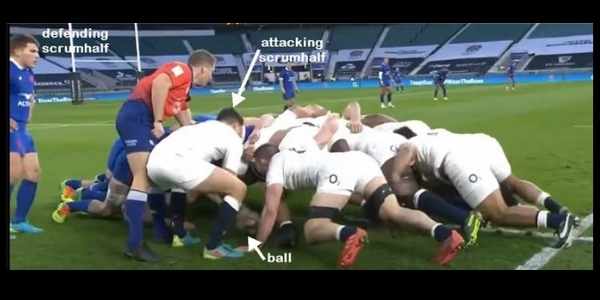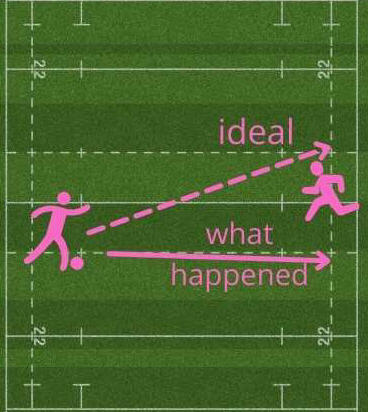Have you ever seen a rugby player kicking the ball backwards? It occasionally happens, but is it allowed or penalized?
You probably know that you can’t pass the ball backwards. So, let’s dive into whether rugby players can kick the ball backwards toward their own try line.
Can You Kick The Ball Backwards In Rugby?
Unlike with passing, players are allowed to kick the ball backwards in rugby.
As the primary goal of kicking is to gain territory, it is rare for a player to kick backwards.
The exception is when a team wants to kick the ball out of play when time is up. Players kick backwards to avoid a charge down.
This usually happens when the team in possession is under pressure in their own half.
Common Scenarios For Kicking The Ball Backwards

A typical example is when the forwards pack down for a scrum when the clock is in the red. The scrum-half will grab the ball as quickly as possible out of the scrum.
He wants to kick the ball out of play without being tackled or blocked by the opposite number nine.
The best way to do so is to turn and run a few steps toward his own try line and kick the ball backwards over the touchline.
Out halves kicking the ball backwards
You’ll see similar situations when a ruck occurs in the 40th or 80th minute. The scrum-half may pass the ball back to the out-half.
When the opposition charges toward out halves, they usually want to kick the ball forwards and high over the advancing defenders’ heads.
But in this scenario, the out-half wants the play to stop for halftime or to end the game. And he certainly doesn’t want to be charged down!
So, the out-half will turn away from the opposition and kick the ball backwards over the try line.
Kicking Backwards By Mistake – Because Of The Wind
This is probably the most common scenario of kicking backwards by mistake.
When there’s a strong wind blowing, the team playing into the wind is always at a disadvantage. Kickers usually compensation by keeping the height and trajectory low.
But this is very difficult for scrum-halves attempting to box kick from the back of a ruck or scrum.
They have to kick the ball high to clear the forwards near the ruck. Sometimes you’ll see a strong wind blow the ball back behind the scrum-half.
Up and under
The other scenario is when a kicker puts up a high ball for teammates to chase. The kicker may also be chasing to gather his own ball.
(Yes, that’s allowed. Check out our article on players catching their own kick).
This is also called a Garryowen, after an Irish club who were renowned for the tactic.
The wind in a stadium is stronger at greater heights. I’ve seen gusts catch a ball and blow it back ten or more meters behind the kicker.
Kicking Backwards By Mistake – Getting The Angle Wrong
Surely, this can’t be done by mistake, right?
Oh, yes it can. And don’t call me Shirley.
I watched a club match recently between Leinster and the Bulls. This was a clash between two continents. Leinster is an Irish club, while the Bulls are South African.
The Leinster outhalf decided to cross-kick the ball to his winger. The perfect cross-kick is to kick across the field at an angle that allows your winger to catch it in full stride.
This is easier to explain with an illustration. Look at the dotted angle of the ideal kick in the picture below.
Unfortunately, the kicker got his angles wrong and the ball dropped slightly behind an imaginary horizontal line from his own position.

The winger had to check his run and retreat a few yards to catch the ball.
Meanwhile, the delighted opposition winger was racing to tackle or intercept the ball.
Kicking Backwards By Mistake – Slicing Off The Boot
Slicing the ball is the nightmare for kickers.
Instead of making a clean connection with the ball, the kick is off the side of the boot. This isn’t getting the angles wrong. It’s a miss-kick that can send the ball anywhere.
And sometimes the ball goes high and slightly behind the kicker i.e. backwards!
The only hope is that the opposition is just as surprised as the kicker’s teammates.
Things can get worse
Back in 2012, Glasgow was playing a match in the Celtic league.
Their fly-half attempted to clear the ball i.e. kick it as far forward as possible.
But he sliced his kick badly. The ball traveled backwards about five meters.
A teammate rushed to clean up his mess and grab the ball. The referee blew a sharp blast on his whistle. Penalty! The unfortunate teammate was offside.

This was a very obscure but strict interpretation of the rugby laws. The teammate should have retreated ten meters behind where the ball landed.
Then, he would have been entitled to turn and rush to grab the ball.
Admittedly, there was a lot of debate amongst other referees about the decision. Not everybody agreed with the interpretation of the offside laws in this situation.
What Happens If A Player Kicks Through His Own Posts?
What if a kicker is trying to clear the ball from his own try line and the wind gusts it back through his own goalposts?
Does the delighted opposition get three points?
Check out our article on whether it’s possible to score an own goal in rugby.